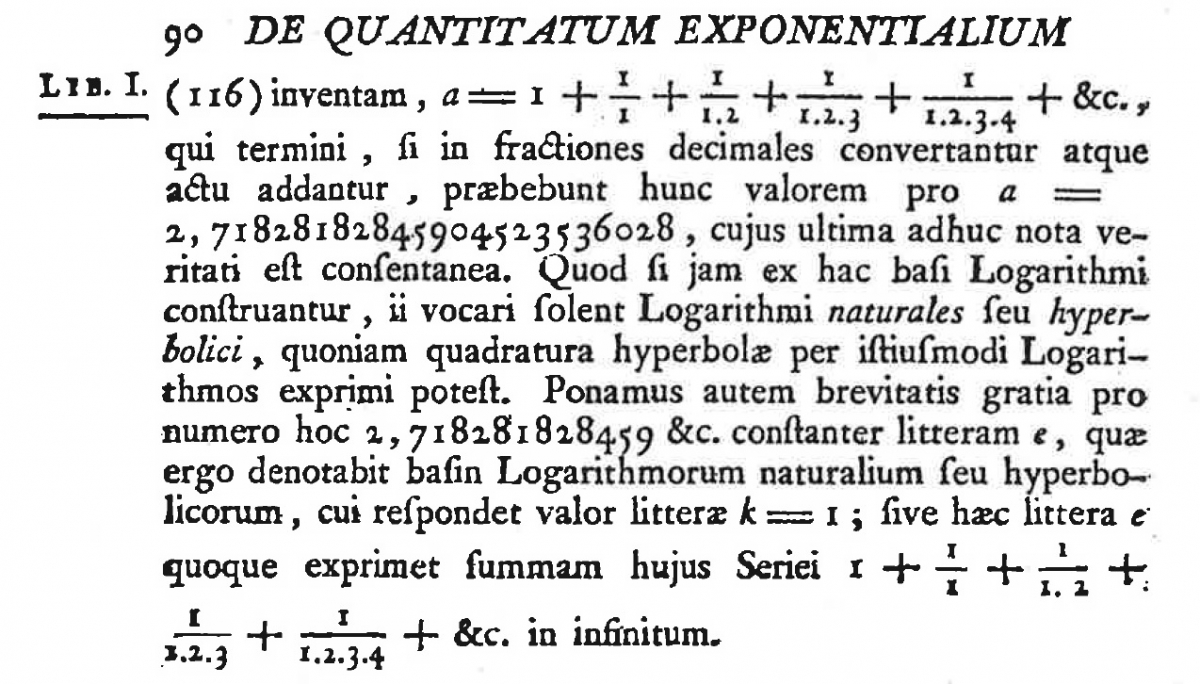- About MAA
- Membership
- MAA Publications
- Periodicals
- Blogs
- MAA Book Series
- MAA Press (an imprint of the AMS)
- MAA Notes
- MAA Reviews
- Mathematical Communication
- Information for Libraries
- Author Resources
- Advertise with MAA
- Meetings
- Competitions
- Programs
- Communities
- MAA Sections
- SIGMAA
- MAA Connect
- Students
- MAA Awards
- Awards Booklets
- Writing Awards
- Teaching Awards
- Service Awards
- Research Awards
- Lecture Awards
- Putnam Competition Individual and Team Winners
- D. E. Shaw Group AMC 8 Awards & Certificates
- Maryam Mirzakhani AMC 10 A Awards & Certificates
- Two Sigma AMC 10 B Awards & Certificates
- Jane Street AMC 12 A Awards & Certificates
- Akamai AMC 12 B Awards & Certificates
- High School Teachers
- News
You are here
Euler's Rediscovery of e: A Mini-Primary Source Project for Introductory Analysis Students
|
Students meet the celebrated number \(e\) in a number of places in their education, and at various levels of sophistication. This famous constant is used in countless applications and appears periodically in the evolution of mathematics. Leonhard Euler explored \(e\) in his Introductio in Analysin Infinitorum [Euler 1748], one of his most influential works.
|
|
Euler wanted to examine exponential and logarithmic functions, especially as infinite series. Part of his challenge in working with logarithmic functions was to find a logarithmic base for which infinite series expansions are convenient. With this goal in mind, Euler derived \(e\), both as the limiting value of the sequence \(\left( 1+1/j\right) ^{j}\) and as the sum of the infinite series \(1+\dfrac{1}{1}+\dfrac{1}{1\cdot2}+\dfrac{1}{1\cdot2\cdot 3}+\dfrac{1}{1\cdot2\cdot3\cdot4}+\cdots.\) Euler's remarkable development involves clever use of infinitely large and small numbers, which is an aesthetic treat but poses difficult questions for a modern student.
 |
This mini-Primary Source Project, designed for an introductory course in analysis, is structured around passages from Euler's Introductio in Analysin Infinitorum. Students see how \(e\) appears naturally in his development of exponential and logarithmic functions. A vital component of this project is giving a modern justification of \(e=\lim_{j\rightarrow\infty}\left( 1+1/j\right) ^{j}\) using Euler's ideas along with some modern theory. The approach using the Monotone Convergence Theorem, as outlined in project exercises, is a common approach in current analysis textbooks. Reading about it in Euler's own words gives context to the exercises and some appreciation of his dexterity with infinitesimals and series, as well as the close connection with \(e\) as a logarithm base to motivate the definition. Moreover, his series development of \(e^{z}\) is an interesting alternative to the Taylor series approach students have seen in introductory calculus courses.
The complete project Euler's Rediscovery of \(e\) (pdf) is ready for student use, and the LaTeX source code is available from the author by request. A set of instructor notes that explain the purpose of the project and guide the instructor through the goals of each of the individual sections is appended at the end of the student project.
This project is the fifth in A Series of Mini-projects from TRIUMPHS: TRansforming Instruction in Undergraduate Mathematics via Primary Historical Sources appearing in Convergence, for use in courses ranging from first year calculus to analysis, number theory to topology, and more. Links to other mini-PSPs in the series appear below. The full TRIUMPHS collection includes thirteen PSPs for use in a real analysis course.
Acknowledgments
The development of the student project Euler's Rediscovery of \(e\) has been partially supported by the TRansforming Instruction in Undergraduate Mathematics via Primary Historical Sources (TRIUMPHS) project with funding from the National Science Foundation’s Improving Undergraduate STEM Education Program under Grants No. 1523494, 1523561, 1523747, 1523753, 1523898, 1524065, and 1524098. Any opinions, findings, and conclusions or recommendations expressed in this project are those of the author and do not necessarily reflect the views of the National Science Foundation.
References
Euler, Leonard. 1748. Introductio in Analysin Infinitorum, Volume 1. Lausanne: Marcum-Michaelem Bousquet. Also in Euler's Opera Omnia, Series 1, Volume 8, pages 1–392. English translation by John Blanton, 1988, Introduction to Analysis of the Infinite, Book 1, New York: Springer.
Dave Ruch (Metropolitan State University of Denver), "Euler's Rediscovery of e: A Mini-Primary Source Project for Introductory Analysis Students," Convergence (May 2018)






